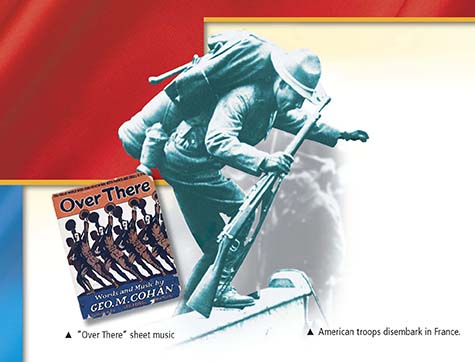SECTION 3: Wilson, War, and Peace

WITNESS HISTORY  AUDIO
AUDIO
War Enthusiasm
Although the first American troops arrived in France in 1917, American soldiers did not reach France in great numbers until 1918. George M. Cohan’s song
“Over There” was used effectively to recruit troops and raise morale.
“Over there, over there.
Send the word, send the word over there,
That the Yanks are coming,
The Yanks are coming …
So prepare, say a pray’r,
Send the word, send the word to beware.
We’ll be over, we’re coming over,
and we won’t come back till it’s over
Over there.”
—From the song “Over There,” written by George M. Cohan in 1917
Objectives
- Understand how the United States military contributed to the Allied victory in the war.
- Describe the aims of the Fourteen Points.
- Analyze the decisions made at the Paris Peace Conference.
- Explain why the United States Senate refused to ratify the treaty ending World War I.
Terms and People
- convoy
- Vladimir Lenin
- John J. Pershing
- Fourteen Points
- self-determination
- League of Nations
- Henry Cabot Lodge
- reparations
- “irreconcilables”
- “reservationists”
NoteTaking
Reading Skill: Sequence As you read, sequence the events leading to the end of World War I in a timeline.

Why It Matters When the United States entered World War I in the spring of 1917, the conflict had become a deadly, bloody stalemate. The war would be won or lost on the Western Front in France. Since 1914, both sides had tried desperately to break the stalemate there—and failed. The American entry into the war would play a key role in the Allied victory. Section Focus Question: How did Americans affect the end of World War I and its peace settlements?
America Gives the Allies the Edge
To European leaders, the United States was a great unknown. Ethnic divisions in America raised questions about how committed American troops would be in combat. Some doubted that the United States could raise, train, equip, and transport an army fast enough to influence the outcome of the war. Desperate German military leaders renewed unrestricted submarine warfare, hoping to end the conflict before the Americans could make a difference.
Allied Convoys Protect Shipping
The Allies immediately felt the impact of the renewed unrestricted submarine warfare. German U-boats sank merchant ships in alarming numbers, faster than replacements could be built. As one merchant ship after another sank to the bottom of the sea, the Allies lost crucial supplies.
Together, the Allies addressed the problem of submarine warfare by adopting an old naval tactic: convoying. In a convoy, groups of




